Search results for: 'stone a'
-
 Neolithic stone tool from Egypt
Neolithic stone tool from EgyptThe Stone Age weapon's point or knife blade is well crafted, with finely serrated edge. From a 100 year old museum collection.
Price: on request Neolithic stone tool from Egypt
Neolithic stone tool from EgyptThe Stone Age weapon's point or knife blade is well crafted, with finely serrated edge. From a 100 year old museum collection.
Price: on request Polychromic Roman mosaic showing a fish
Polychromic Roman mosaic showing a fishMuseal erhaltenes Paneau, sehr intensive, leuchtende Farben. Herausragendes, ungewöhnlich gearbeitetes Stück.
Price: on request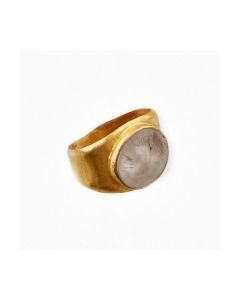 Roman gold ring with intaglio
Roman gold ring with intaglioA lovely piece of Roman jewellery in good condition. The chalcedony intaglio shows a portrait head. Dating to the 3rd century AD.
Price: on request Hand axe from Galilee
Hand axe from GalileeBig paleolithic hand axe. The universal stone age tool could be use as a borer or cutting tool. Around 500,000 to 200,000 BC.
Price: on request Conoid stamp seal with spade of Marduk
Conoid stamp seal with spade of MardukThe stamp shows the spade of Marduk, patron deity of the city of Babylon. Above a crescent, symbolizing the moon god Sin. 7th to 6th century BC.
Price: on request Old Babylonian cylinder seal
Old Babylonian cylinder sealThis Old Babylonian seal with a worship scene is made from lapis lazuli, a very rare choice for this period.
Price: on request Cone-shaped stamp seal with star of Ishtar
Cone-shaped stamp seal with star of IshtarThe seal depicts a tree of life with a rhomb and eight-pointed star, symbol of Ishtar. 7th to 6th century BC.
Price: on request Roman facade decoration shaped as theatre mask
Roman facade decoration shaped as theatre maskImpressive and striking marble mask. It once adorned the upper facade of a villa or a public building during Roman Imperial times.
Price: on request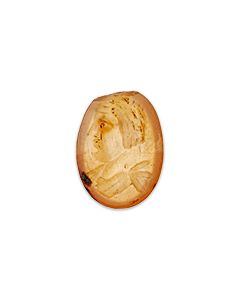 Roman intaglio with bust
Roman intaglio with bustThe gemstone made of yellow-orange carnelian shows a male portrait bust.
Price: on request Neo-Assyrian seal with mythological creature
Neo-Assyrian seal with mythological creatureThe octagonal stamp seal shows a hybrid creature and a priest. It originates from the Neo-Assyrian culture of the 8th to 7th cent. BC.
Price: on request Roman marble figurine of Salus
Roman marble figurine of SalusMarble torso of Salus or Hygeia, the goddess of health, holding a serpent in her arms. From the collection of Dr. Bruno Kirschner, Israel. Exported from Israel with permit of the IAA.
Price: on request Sehr großes polychromes römisches Mosaik - stehender Pfau
Sehr großes polychromes römisches Mosaik - stehender PfauMuseal erhaltenes Paneau, aus ca. 25.000 Steintesserae bestehend. Professionell auf feste Unterlage übertragen und gerahmt.
Price: on request Roman glass paste with depiction of a warrior in armor
Roman glass paste with depiction of a warrior in armorThe piece is based in a high quality gem stone and has been molded with all details. Oval shape and nice colour sparkling in red and purple.
Price: on request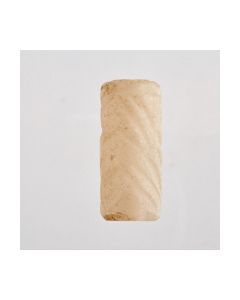 Mesopotamian cylinder seal with abstract scene
Mesopotamian cylinder seal with abstract sceneThe milky white stone is engraved with a scene that stands out by its high degree of abstraction. Late Uruk to Djemdet Nasr period, around 3000 BC.
Price: on request Achaemenid stamp seal
Achaemenid stamp sealThis beautiful stamp seal is from the First Persian Empire of the Achaemenids or from parts under Greek control. 5th to 4th cent. BC.
Price: on request Two Mesopotamian mosaic cones
Two Mesopotamian mosaic conesThe pieces were part of a mosaic decoration of a Mesopotamian structure in the 4th Millenium BC. The temple architecture from Uruk is a particularly well known example of such a use.
Price: on request Large neolithic axe head
Large neolithic axe headA tool from the Early Neolithic of Europe. Nicely polished and impressive by its size and weight.
Price: on request Greek terracotta head of a woman
Greek terracotta head of a womanAbout 5th century B.C. From an old collection of a Frech engineer.
Price: on request Pyramidal stamp seal
Pyramidal stamp sealMade from beautiful light green stone during the early Iron Age. The seal is from northern Syria or southern Anatolia and bears an abstract depiction of a stag.
Price: on request Head of a woman with melon coiffure
Head of a woman with melon coiffureAbout 5th century B.C. From an old collection of a Frech engineer.
Price: on request Hellenistic female head with melon coiffure
Hellenistic female head with melon coiffureAbout 5th century B.C. From an old collection of a Frech engineer.
Price: on request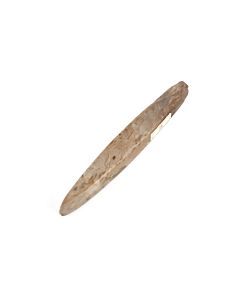 Neolithic chisel from Northern Germany
Neolithic chisel from Northern GermanyElegantly shaped chisel with two polished sides. Made of grey flint. Approx. 3400 to 2400 BC.
Price: on request Neolithic axe head
Neolithic axe headNicely crafted Stone Age tool made of wonderful light green jadeite. From southern France.
Price: on request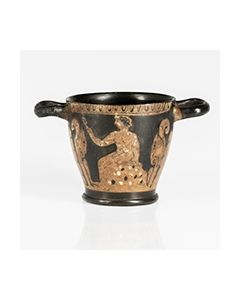 Very large Campanian red figure skyphos
Very large Campanian red figure skyphosDecorated with figures of youths, framed by palmettes. From an old German Frankonian collection. Acquired in the 1920s - 1930s.
Price: on request Pair of early Byzantine gold earrings
Pair of early Byzantine gold earringsBeautiful jewellery with beads made of emerald and garnet. Made in the eastern part of the Mediterranean during the 6th to early 7th century.
Price: on request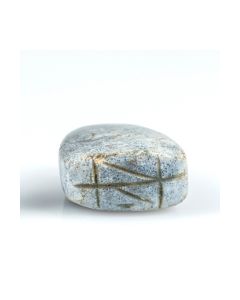 Near Eastern conoid stamp seal
Near Eastern conoid stamp sealColourful seal with geometrical decoration. Neo-Babylonian or Achaemenid, 6th to 5th cent. BC.
Price: on request Gnostic intaglio with Abraxas
Gnostic intaglio with AbraxasIt shows the god Abraxas with human torso, cock's head and serpants for legs, holding whip and shield. Magical formulas on both sides of the gem. 2nd or 3rd century.
Price: on request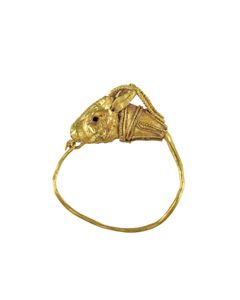 Hellenistic gold earring with antelope head
Hellenistic gold earring with antelope headEar pendant with plastically modeled head of an antelope. The elaborately made head is typical for hellenistic gold jewellery.
Price: on request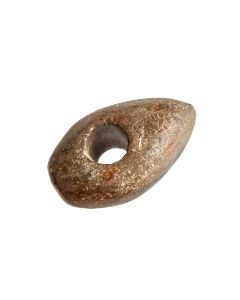 Small battle axe of the Single Grave culture
Small battle axe of the Single Grave cultureThe axe head from the younger Stone Age has a compact shape. Axes that have clearly been used as weapons are rare. Most axe types have probably served peaceful purposes.
Price: on request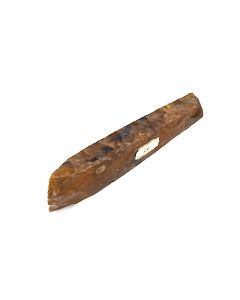 Neolithic axe head from Luetzow in Northern Germany
Neolithic axe head from Luetzow in Northern GermanyNice polished axe from brown flint. It was found more than 100 years ago near the town of Luetzow.
Price: on request Early flat axe from Judea
Early flat axe from JudeaInteresting bronze axe head from Early Bronze Age. The piece was found in Judea.
Price: on request Early flat axe from Judea
Early flat axe from JudeaCompact bronze axe head from Early Bronze Age. The piece was found in Judea.
Price: on request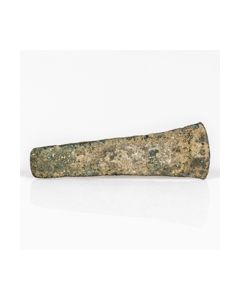 Early flat axe from Judea
Early flat axe from JudeaTrapezoidal axe head from Early Bronze Age. The piece was found in Judea.
Price: on request Scarab mounted in a gold ring
Scarab mounted in a gold ringThe fantastic piece of jewellery is from the Third Intermediate Period of Ancient Egypt, probably dating to the Nubian Kushite rule of the Twenty-fifth Dynasty.
Price: on request Vessel of the Linear Pottery culture
Vessel of the Linear Pottery cultureThe beautifully decorated tableware or cookware was made by the earliest peasants of Central Europe, the Late Stone Age Linear Band Ware settlers. A find from Southern Germany in great condition.
Price: on request

